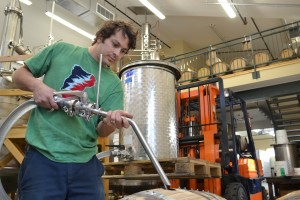Live from the Hive: March 2014
“Feast Your Eyes” by Annie Watson
As March begins, the cold continues unabated. Let’s feast our eyes on something other than more snow and ice. This photo shows a worker honey bee on a sumac flower. Sumac blooms in June and is a major food source for Vermont’s honey bees. This picture is a reminder of the coming of spring. The amber blob on the bee’s back leg is pollen.
In March, the beekeeper checks on the hives and feed the colony honey or some form of sugar if necessary — this is the month when colonies can starve. Believe it or not, if the temperatures warm up, we will begin to see the bees venturing out for the first pussy willow and alder pollen of later this month, at least in southern Vermont. The spring equinox arrives on March 20th, when the day and night are of equal length. Happy Spring!
 Andrew Pinault, Caledonia Spirits Distiller, filling a barrel of Barr Hill Reserve Tom Cat
Andrew Pinault, Caledonia Spirits Distiller, filling a barrel of Barr Hill Reserve Tom Cat